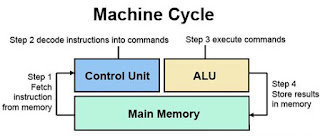Alternately referred to as a processor, central processor, or microprocessor, the CPU (pronounced sea-pea-you) is the Central Processing Unit of the computer. A computer's CPU handles all instructions it receives from hardware and software running on the computer.
Tip: The CPU is often referred to as the brain of the computer. However, it is more appropriate to refer to software as the brain and the CPU as a very efficient calculator.
Note: Many new computer users may improperly call their computer and sometimes their monitor
the CPU. When referring to your computer or monitor, it is proper to
refer to them as either the "computer" or "monitor" and not a CPU.
The picture below is an example of what the top and bottom of an Intel Pentium processor. The processor is placed and secured into a compatible CPU socket found on the motherboard.
Processors produce heat so are covered with a heat sink
to keep them cool and running smoothly.Components of the CPU
In the CPU, the primary components are the ALU (Arithmetic Logic Unit) that performs mathematical, logical, and decision operations and the CU (Control Unit) that directs all of the processors operations.
Over the history of computer processors, the speed (clock speed) and capabilities of the processor have dramatically improved. For example, the first microprocessor was the Intel 4004 that was released November 15, 1971, and had 2,300 transistors and performed 60,000 operations per second. The Intel Pentium processor
pictured above has 3,300,000 transistors and performs around 188,000,000 instructions per second.
Types of CPUs
In the past, computer processors used numbers to
identify the processor and help identify faster processors. For example,
the Intel 80486 (486) processor is faster than the 80386 (386)
processor. After the replace of the Intel Pentium processor (which
would technically be the 80586), all computer processors started using
names like Athlon, Duron, and Pentium.
Today, in addition to the different names of computer processors there are different architectures (32-bit and 64-bit), speeds, and capabilities. Below is a list of the more common types of CPUs for home or business computers.
Note: There are multiple versions for some of these CPU types.





0 comments:
Post a Comment